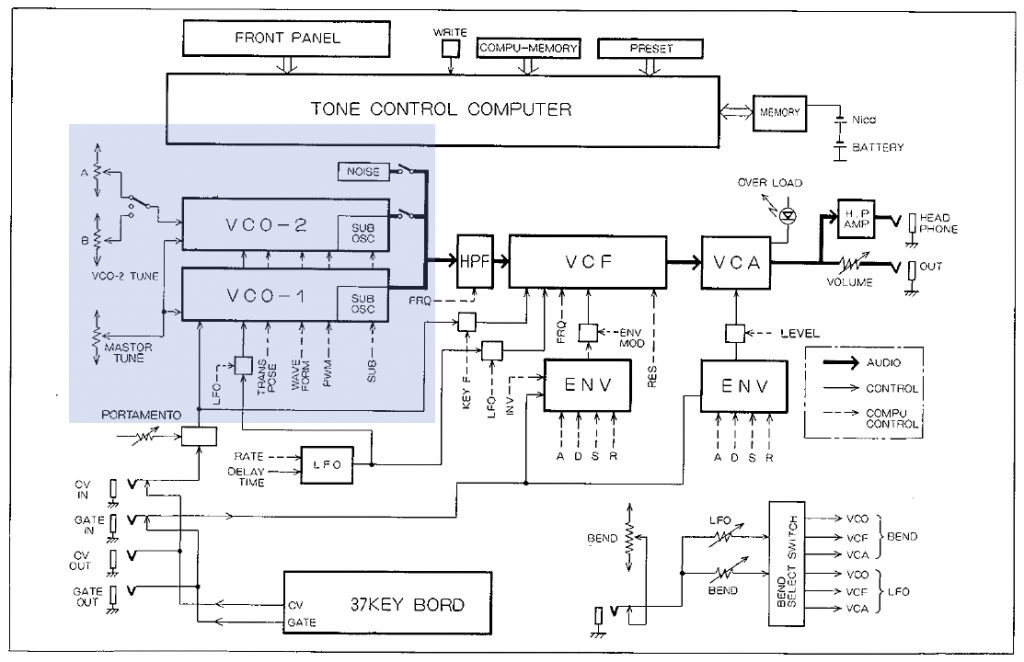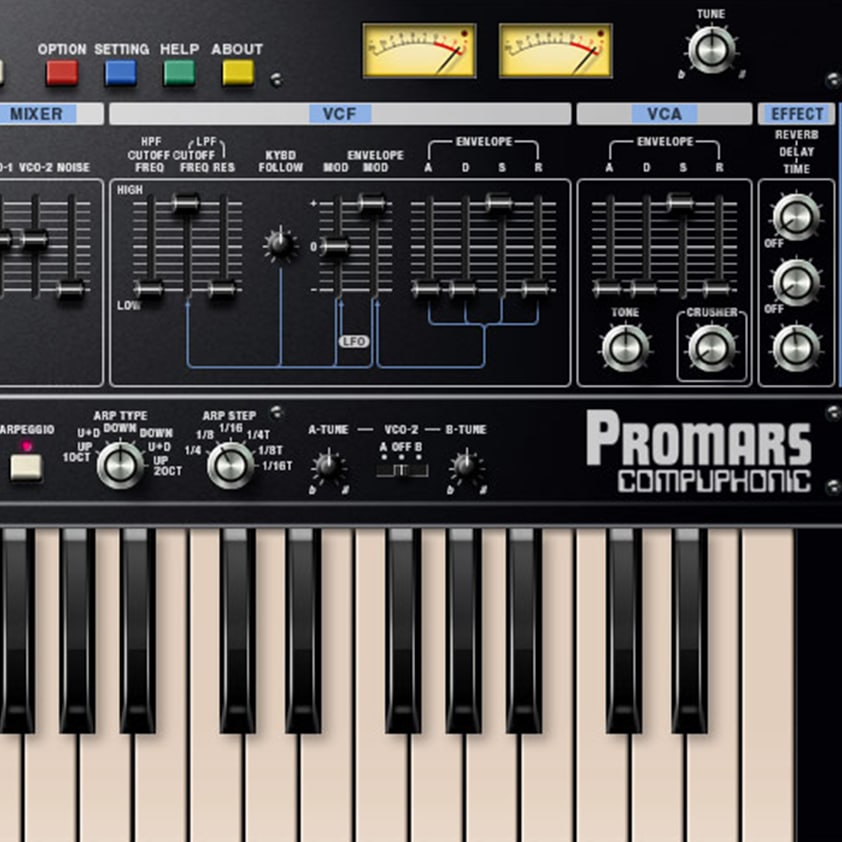1979 was an exciting year for synthesizers at Roland. The introduction of the Roland SH-2 Monophonic Synthesizer paved the way for the arrival of two COMPUPHONIC synthesizers: the JUPITER-4 Polyphonic Synthesizer and the MRS-2 PROMARS Monophonic Synthesizer.
The COMPUPHONIC synthesizers used a microprocessor chip to control their all-analog circuit voltages. Moreover, this computer brain provided an impressive eight presets, allowing users to save and recall their favorite sounds on stage. A technological breakthrough in 1979, it made the JUPITER-4 and PROMARS a powerful combination on stages and in the studio.
While not as well-known as the JUPITER-4, the oscillator structure and “compu-memory” of the PROMARS made it a highly regarded instrument. The keyboard has a special place among the classic Roland monosynths, and in the Roland Cloud Legendary Series.
Let’s Talk Oscillators
The PROMARS was more than a “monophonic JUPITER-4.” While the JUPITER-4 had one VCO and one SUB-OSC per voice, the PROMARS had two of each. The unique arrangement of the two VCOs and two SUB-OSC gives the monosynth extra fatness compared to other “monos.”
Indeed, an experienced synthesist could take advantage of this oscillator setup. The PROMARS had thick bass and lead tones available at the flick of a switch. Below, the blue section in the block diagram displays the oscillator section:

The LFO, TRANSPOSE, WAVEFORM, PULSE WIDTH MODULATION, and SUB-OSC simultaneously control both VCO-1 and VCO-2. As a result, the “stacked” oscillator configuration provided the single note with twice the punch and harmonics. However, the power of the PROMARS lay in two small knobs and one switch: VCO-2 TUNE A & B.
The VCO-2 TUNE switch gave players the option of selecting between an “A” fine-tune, “B” fine-tune, or OFF. This provided the synthesist three distinct options. OFF gave the thick, stacked monosynth sound, whereas “A” could be slightly detuned for a chorus effect. Finally, “B” could be set to an interval (e.g. a fifth). This configuration, combined with the SUB-OSC switch, meant the PROMARS moved from bass to screaming lead in seconds.
Uncharted Territory
The PROMARS featured two classic clean and smooth Roland filters: a high-pass (HPF) and low-pass (LPF). The HPF CUTOFF FREQ is the only parameter adjustable on the HPF but ideal for shaping the NOISE source for percussive effects. The low-pass filter had controls for CUTOFF FREQ, RESONANCE, with LFO and envelope modulation. One could crank the RESONANCE of the LPF to produce its own smooth, sine-wave via self-oscillation. Inventive users could also play it as an extra oscillator, using 100% (“3”) KYBD FOLLOW.
However, to really push the PROMARS into new sonic territory, the trick was to modulate different parameters with the super-fast LOW-FREQUENCY OSCILLATOR (LFO). Modulating the frequency of the VCOs with the LFO created a warbling pitch tone depending on which of the four LFO waveforms one selected. Sliding the RATE up sent the LFO speed into the audio range, turning those warbling sounds (AM – amplitude modulation) into overtone-rich, clanging textural tones (FM – frequency modulation).
As a matter of fact, this rich frequency modulation owed to the basic waveform of the VCO. It became a much more complex waveform, resulting in harmonic sounds like bells, gongs, and other percussive instruments. The resulting sounds meant the PROMARS took you to a place few analog monosynths could.
Eleven Secret Sounds
Along with the eight COMPU-MEMORY banks, came ten preset sounds: Bass, Strings, Funky Clav, Piano, Voice, Trombone, Sax, Trumpet, plus Synth I and Synth II.
As a bonus, we thought we’d provide you something few have ever seen. These eleven translated patch settings come directly from the original Japanese PROMARS manual.











Analog Circuit Behavior
Roland Cloud users can enjoy this rare instrument with Analog Circuit Behavior (ACB) technology. ACB faithfully captures the sound and feel of our most revered classics. The technique uses original design specs, and a detailed, part-by-part analysis of each analog circuit.
While the sound and behavior of the ACB PROMARS are totally accurate, we couldn’t help but improve a few things. The VCOs possess increased range settings. Likewise, the LFO has a “Random” waveform setting. Finally, the Noise and Pulse Width sections allow for full range control of those parameters.
Renowned for its raw vintage tone, the PROMARS’ unique VCO configuration makes it one of the fattest monosynths of all time.







